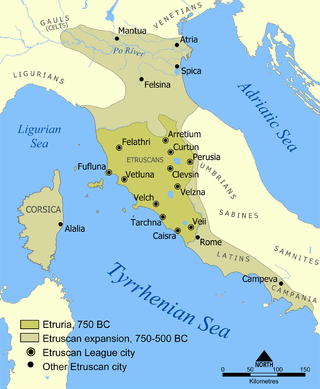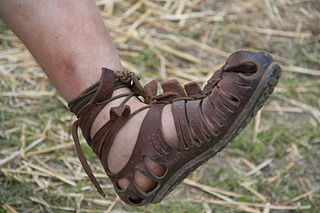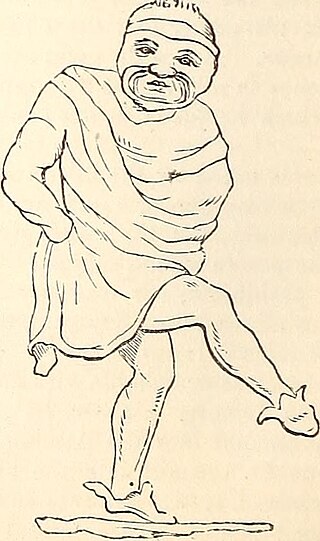Related Research Articles

The Etruscan civilization was an ancient civilization created by the Etruscans, a people who inhabited Etruria in ancient Italy, with a common language and culture who formed a federation of city-states. After conquering adjacent lands, its territory covered, at its greatest extent, roughly what is now Tuscany, western Umbria, and northern Lazio, as well as what are now the Po Valley, Emilia-Romagna, south-eastern Lombardy, southern Veneto, and western Campania.

Etruria was a region of Central Italy delimited by the rivers Arno and Tiber, an area that covered what is now most of Tuscany, northern Lazio, and north-western Umbria. It was inhabited by the Etruscans, an ancient civilization that flourished in the area from around the 8th century BC until they were assimilated into the Roman Republic in the 4th century BC.

The toga, a distinctive garment of Ancient Rome, was a roughly semicircular cloth, between 12 and 20 feet in length, draped over the shoulders and around the body. It was usually woven from white wool, and was worn over a tunic. In Roman historical tradition, it is said to have been the favored dress of Romulus, Rome's founder; it was also thought to have originally been worn by both sexes, and by the citizen-military. As Roman women gradually adopted the stola, the toga was recognized as formal wear for male Roman citizens. Women found guilty of adultery and women engaged in prostitution might have provided the main exceptions to this rule.

The stola was the traditional garment of Roman women, corresponding to the toga that was worn by men. It was also called vestis longa in Latin literary sources, pointing to its length.
Gaius Verres was a Roman magistrate, notorious for his misgovernment of Sicily. His extortion of local farmers and plundering of temples led to his prosecution by Cicero, whose accusations were so devastating that his defence advocate could only recommend that Verres should leave the country. Cicero's prosecution speeches were later published as the Verrines.

A petasos or petasus (Latin) is a broad brimmed hat of Thessalian origin worn by ancient Greeks, Thracians and Etruscans, often in combination with the chlamys cape. It was made of wool felt, leather, straw or animal skin. Women's versions had a high crown while those for men featured a lower crown. It was worn primarily by farmers, travellers and hunters, and was considered characteristic of rural people. As a winged hat, it became the symbol of Hermes, the Greek mythological messenger god.
"In Verrem" is a series of speeches made by Cicero in 70 BC, during the corruption and extortion trial of Gaius Verres, the former governor of Sicily. The speeches, which were concurrent with Cicero's election to the aedileship, paved the way for Cicero's public career.

Caligae are heavy-soled hobnailed military sandal-boots that were worn as standard issue by Roman legionary foot-soldiers and auxiliaries, including cavalry.

Clothing in ancient Rome generally comprised a short-sleeved or sleeveless, knee-length tunic for men and boys, and a longer, usually sleeved tunic for women and girls. On formal occasions, adult male citizens could wear a woolen toga, draped over their tunic, and married citizen women wore a woolen mantle, known as a palla, over a stola, a simple, long-sleeved, voluminous garment that modestly hung to cover the feet. Clothing, footwear and accoutrements identified gender, status, rank and social class. This was especially apparent in the distinctive, privileged official dress of magistrates, priesthoods and the military.
Larissa Bonfante was an Italian-American classicist, Professor of Classics emerita at New York University and an authority on Etruscan language and culture.
Lucius Caecilius Metellus was a Roman aristocrat. He was praetor in 71 BC. He succeeded Gaius Verres as governor of Sicily in 70 BC. He died in office as consul in 68 BC. His co-consul was Quintus Marcius Rex.
Quintus Caecilius Metellus Creticus was a politically active member of the Roman upper class. He was praetor in 74 BC and pontifex from 73 BC until his death. He was consul in 69 BC along with Quintus Hortensius Hortalus.

Ancient Carthage was an ancient Semitic civilisation based in North Africa. Initially a settlement in present-day Tunisia, it later became a city-state and then an empire. Founded by the Phoenicians in the ninth century BC, Carthage reached its height in the fourth century BC as one of the largest metropoleis in the world. It was the centre of the Carthaginian Empire, a major power led by the Punic people who dominated the ancient western and central Mediterranean Sea. Following the Punic Wars, Carthage was destroyed by the Romans in 146 BC, who later rebuilt the city lavishly.

The modius is a type of flat-topped cylindrical headdress or crown found in ancient Egyptian art and art of the Greco-Roman world. The name was given by modern scholars based on its resemblance to the jar used as a Roman unit of dry measure, but it probably does represent a grain-measure, and symbolizing one's ability to learn new information by having an open mind with an empty cup. Serapis was the main idol/figurehead at the Library of Alexandria during the ancient Egyptian & Roman alliance.

A radiant or radiate crown, also known as a solar crown, sun crown, Eastern crown, or tyrant's crown, is a crown, wreath, diadem, or other headgear symbolizing the Sun or more generally powers associated with the Sun. Apart from the Ancient Egyptian form of a disc between two horns, it is shaped with a number of narrowing bands going outwards from the wearer's head, to represent the rays of the Sun. These may be represented either as flat, on the same plane as the circlet of the crown, or rising at right angles to it.

A soccus or sýkkhos, sometimes given in translation as a slipper, was a loosely fitting slip-on shoe in Ancient Greece and Rome with a leather sole and separate leather, bound without the use of hobnails. The word appears to originate from the languages of ancient Anatolia. They were worn by Ancient Greek comedic actors, contrasted with the cothurni worn by tragedians, and were borrowed into Latin and worn by the ancient Romans. The soccus was considered effeminate, and the emperor Caligula is described as having worn them, possibly as a form of insult. Later socci became popular with the general public, and several types were listed in the Edict of Diocletian. The word was adopted into West Germanic languages for similarly light footwear, eventually becoming English socks.
The gens Rubria was a plebeian family at ancient Rome. Members of this gens are first mentioned in the time of the Gracchi, but they did not rise to prominence until imperial times. The first of the Rubrii to obtain the consulship was Rubrius Gallus, some time before AD 68.
Chelidon was a Roman courtesan, famed for her influence during the praetorship of Gaius Verres.
In Ancient Rome, a mappa was a white cloth or napkin used by the presiding magistrate to signal the start of a chariot race at a hippodrome by tossing it down into the arena. Its use is attested to beginning in the early years of the Roman Empire, though chariot races pre-date it by hundreds of years. Any piece of white cloth could serve as a mappa. Roman consuls were often depicted on coins holding a mappa in their raised right hand, and the mappa therefore became represented as an item of imperial regalia.
References
- ↑ Javier Velaza, Insularity, Identity and Epigraphy in the Roman World
- ↑ Judith Lynn Sebesta, Larissa Bonfante, The World of Roman Costume
- ↑ Anise K. Strong: Prostitutes and Matrons in the Roman World
- Matthew Dillon, Lynda Garland, Ancient Rome: A Sourcebook
- Edith Hall, Rosie Wyles, New Directions in Ancient Pantomime
- Javier Velaza, Insularity, Identity and Epigraphy in the Roman World
- Judith Lynn Sebesta, Larissa Bonfante, The World of Roman Costume